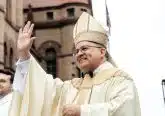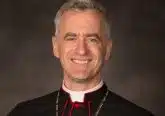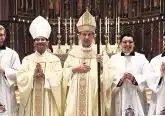Local bishops: Steubenville-Columbus diocesan merger back in play
National Catholic Register, Dec 13, 2023 / 17:25 pm
The bishops who lead the dioceses of Columbus and Steubenville in Ohio could present a merger plan to the U.S. Conference of Catholic Bishops as early as June 2024, according to the bishops of both dioceses.
It’s not yet a done deal, the bishops told the National Catholic Register, CNA’s sister news partner, but staff members from the two dioceses met recently to exchange information. It could take about three or four months to determine whether a merger is feasible, Bishop Earl Fernandes of Columbus and Bishop Paul Bradley of Steubenville said.
If the two bishops, the papal nuncio, Ohio’s other bishops, and the U.S. Conference of Catholic Bishops agree, a plan would be submitted to Rome for the pope’s approval.
The bishops released a joint written statement Monday saying that the apostolic nuncio to the United States, Cardinal Christophe Pierre, “has asked the dioceses to work together to consider how different dimensions of the dioceses, including the temporal aspects of life, might be affected by such a proposal.” The bishops’ statement described merger talks as “very preliminary.”
A similar announcement in October 2022 by Bishop Jeffrey Monforton, Steubenville’s previous bishop, drew significant opposition from people in the diocese and from priests.
“They felt like they had not been sufficiently consulted. They themselves were unaware. In fact, their reaction was one of shock — how could this be? And so I think that’s one of the reasons why now we want to have a wider consultative process,” Fernandes told the Register.
On Monday afternoon, the Register conducted online interviews with Fernandes, who became bishop of Columbus in May 2022, and Bradley, a recently retired diocesan bishop who became apostolic administrator of Steubenville on Sept. 28.
The two bishops and key officials from both dioceses met Dec. 5 at a conference center in Cambridge, Ohio, which is about an hour and 20 minutes’ drive from both cities. Among the details officials have to work out is how they might reconcile insurance coverage as well as salaries and pensions for priests and lay employees.
The bishops said the papal nuncio has encouraged the talks between the Diocese of Steubenville, which is decreasing in population, and the Diocese of Columbus, which is growing.
“The question is not just, is this going to be for the good of the Church here in Steubenville?” Bradley said. “Is it going to be good for the Church in Columbus as well? For the Church as a whole? So I think those are also, as Bishop Fernandes said, that’s why we’re both being asked to look at all of the factors to contribute to the best possible decision that will be made.”
Steubenville’s long decline
The Diocese of Steubenville consists of 13 counties in east-central Ohio and southeastern Ohio; eight of the counties border West Virginia. The diocese was created in November 1944 out of territory previously part of the Diocese of Columbus, which at the time received some territory from the Archdiocese of Cincinnati.
At the time the diocese was created, the city of Steubenville had about 35,000 people. It now has about half that — 18,000. That mirrors a long-term economic decline in the area, largely driven by the decline of the steel and coal industries in nearby western Pennsylvania and West Virginia.
Mass attendance in the Diocese of Steubenville is high, “and the priests there that I’ve met have a kind of missionary sort of zeal,” Fernandes told the Register.
“But there aren’t as many people in the region and not as many Catholics in the region,” Fernandes said. “… The economic forces outside of what’s happening within the Church have direct implications.”
The diocese has about 50 parishes but only 31 priests, Fernandes said, and a significant number of the priests are elderly.
The Diocese of Steubenville has taken financial hits during the past several years.
A plan announced in 2007 to replace the diocese’s cathedral fizzled after the bishop at the time decided the debt would be too risky. Eventually, even a plan to renovate the current cathedral announced in 2013 was abandoned in May 2018 when the diocese discovered that high-ranking officials for years had diverted funds that were supposed to pay income taxes and payroll taxes to the federal government.
In July 2020, David Franklin, former longtime comptroller of the diocese, pleaded guilty to federal charges while admitting he failed to pay the Internal Revenue Service on behalf of the diocese $2.7 million between 2004 and 2016, instead embezzling about $300,000 for himself and diverting the rest. Franklin was sentenced to one year in federal prison.
As a result, the diocese had to pay the Internal Revenue Service $2.7 million in back withholding taxes and payroll taxes plus $1 million in interest on the late tax payments.
In April 2021, Monsignor Kurt Kemo, former vicar general of the Diocese of Steubenville, pleaded guilty to a state charge of embezzling $300,000 from the diocese. Kemo was sentenced to six months in jail.
The former comptroller and the former vicar general — whom a lawyer for Franklin described as “close,” having been friendly for years — diverted the withholding and payroll tax funds into an off-the-books diocesan checking account that other diocesan officials didn’t know about.
Kemo used the slush fund to pay for trips, meals, clothing, credit card bills, and flying lessons, among other things, according to court documents in Franklin’s federal criminal case in U.S. District Court for the Southern District of Ohio.
Kemo also used the account to pay unaccounted-for bonuses to 10 other employees of the diocese, according to a December 2020 sentencing memorandum Franklin’s lawyer produced in Franklin’s federal criminal case.
In an unrelated matter, in July 2022, the Diocese of Steubenville settled a lawsuit filed by a woman impregnated by a pastor, then-Father Henry Foxhoven, during a sexual relationship that she said started when she was 16. The woman initially sought $1 million; the settlement amount was not announced.
Foxhoven was sentenced to 12 years in prison on three counts of sexual battery in November 2018. Pope Francis dismissed Foxhoven from the clerical state in March 2020.
Three months after the lawsuit settlement, in October 2022, the head of Steubenville Diocese at the time, Bishop Monforton, announced his interest in merging the diocese with the Diocese of Columbus. Monforton cited declines in population and priests.
Negative reaction from people and priests in the diocese led Monforton to abandon the merger talks in November 2022, a week before bishops at the U.S. Conference of Catholic Bishops’ fall meeting were scheduled to discuss them. In September of this year, Pope Francis transferred Monforton, 60, to auxiliary bishop of the Archdiocese of Detroit, where he began as a priest.
The Register asked Bishops Bradley and Fernandes whether the Diocese of Steubenville’s financial reversals in recent years are driving the merger talks.
Bradley called diocesan officials’ crimes that came to light in recent years “scandalous situations” but said the economy and demographics in eastern Ohio have more to do with the possible merger.
“I think with each and every one of those, the appropriate responses and reparations were made,” Bradley said, referring to the scandals. “So I think those are separate from the question at hand. The question at hand has to do with the viability of the diocese. Finances, of course, are part of that question of viability, but so are some of the other factors that are facing this part of the state of Ohio, with population decline and economic factors.”
Fernandes said the goal is to come up with a structure that best enables the Church to bring people to God.
“The pope keeps saying we need to move from maintenance to mission. And we’re all on the same page with respect to the mission of evangelization. And so I think that’s one of the things. So how can we best evangelize everybody in this territory, in this part of the state of Ohio?” Fernandes said.
The Register asked the bishops if merger talks suggest decline of the Catholic Church in the United States.
“I would say it’s a time of transition. It’s not about decline. It’s about adjusting, trying to adjust to times of transition,” Bradley said. “And as Bishop Fernandes had alluded to, what the Holy Father is calling the whole Church to become aware of, we can’t just be about maintaining what is. We always need to be focused on how can we take the good news of the Gospel and bring it to the population around us that is increasingly unchurched, unevangelized.”













